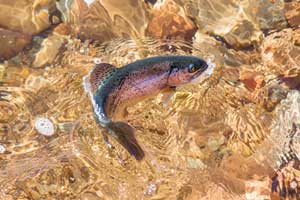Rainbow Trout Spring Fishing

The best flies to use in Spring are insect flies. These are very effective when the rainbow trout are along the coast and in rivers. There’s an abundance of insect life falling into the river and lakes from the over-hanging plant life.
Popular flies include deerfly, mayflies, damsel flies and dragon flies.
Seasonal movement
In the winter rainbow trout are found in the deep but come to the shallow sections as these start to warm up first in the Spring. These fish will tolerate a wide range of water temperatures. They can be found in water ranging from 40°F/4°C to 75°F/23°C with the optimal temperature being from 55°F/12.7°C to 60°F/15.6°C.
Rainbow Trout and oxygen
Most anglers forget about the importance of oxygen for Rainbow Trout. After all, do we humans worry about the oxygen levels? If water isn’t circulating, it doesn’t pick up oxygen. When lakes are frozen, their oxygen levels drop.
When the ice breaks up Rainbow Trout make for the shallows as they have much higher oxygen levels once the ice is melted. Coupled with warmer water and an abundance of baitfish in the shallows spawning, you’d be crazy to fish anywhere else on the lake in the spring.
However conditions change by the end of April as the water column changes and raises the oxygen content throughout the lake.
Spring lake fishing tips
Consider the use of a canoe, kayak or rowboat with a small electric motor. These boats work best in isolated areas where there’s little boat traffic. If there’s no gas motor, the fish won’t be scared away. Pay careful attention to weather conditions as these boats quickly become unsafe in bad weather on larger lakes.
- Troll with streamer flies using long lines between 50 to 75 feet long.
- Focus on breaklines, shoals and bays using a typical S pattern to the shore. Lift the rod occasionally, twitching the line to replicate a ‘lifelike bait fish’ movement.
Trolling can also be done using baitcasters and is the recommended method for most anglers for lake habitats. It’s easier and the gear is much more affordable.
Spoons and plugs will work best when Rainbow trout are deeper in the water.
Best lures
- In the early spring when they’re in the shallows, go with a simple single blade spinner with a smelt or alewife tied on when fishing the inland lakes. Consider using a planer board when you’re wanting to keep the bait or spinner at a specific depth.
Spring river fishing
- Rivers with naturally reproducing Rainbow Trout can be caught using artificial lures on a single hook only. Light tackle is best.
- For most of their distribution, a light to medium rod and reel combination is sufficient with a monofilament line between 4 to 8 pounds.
- Hooks need to be between #6 to #10.
- For river fishing, popular baits include live earthworms, salmon roe and canned corn kernels.
- Small spinners and spoons are still effective for river fishing so long as there’s not a lot of underwater debris.
Fly fishing is of course the most popular style for river fishing.
- For beginner anglers, we suggest going with dry flies as these are a lot easier to learn than wet flies.



